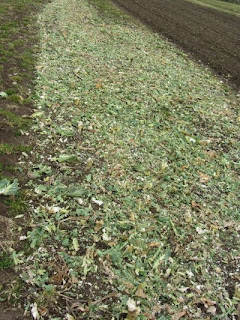The RMG was set up as a social enterprise by RCMA (the organization that operates Riverside Farmers’ Market in Cardiff). It is located on the edge of St Hilary on Coed Hills Farm, which it shares with the Coed Hills Rural Artspace, in the heart of the Vale of Glamorgan. RMG grows food for a local organic vegetable box scheme (with many customers in nearby Cowbridge), the Riverside Farmers’ Market and a number of restaurants in the Cardiff area (e.g., Arboreal in Cowbridge and Casanova in Cardiff). It is run as a cooperative with around 150 local shareholders (shares start at £50).
Head Grower Sophie Durnan gave us an introductory talk, followed by a tour of Coed Hills. The RMG was started four years ago and comprises a 5-acre field, on which are two polytunnels. Crops are grown in rows across the 300 foot-wide field. The focus is on high value crops, and a wide variety of produce for the vegetable boxes. Crops grown include kale, cauliflower and other brassicas, courgettes, squash, leeks, fennel, onions, tomatoes, cucumbers, and a range of salads. We were taken around the field, which will shortly be ploughed ready for the planting of this season’s crops.
The field is split into six areas in terms of crop rotation. Green manures are grown as part of the rotation; this is now known to be the best way to incorporate nitrogen into the soil. A short-term crop, such as rye grass, mustard or clover, which can be subsequently flailed and dug in, improves the soil more than if a field is standing fallow for an equivalent period of time. This philosophy is extended at RMG, where crop residues (e.g., last year’s cauliflowers) are cut up with a flail mower and dug in, rather than being removed and composted. Brassicas are not grown on the same part of the field again for around 5 years, to prevent the recurrence of diseases such as clubroot. The brassicas like the alkaline soil conditions here; though they are covered with a fine plastic mesh to prevent attack by flea beetle, which is prevalent in the area.
The soil at Coed Hills is clayey and stony. Root crops, such as carrots and parsnips are not grown in the field (although there are some early carrots currently in a polytunnel). Potatoes are also not grown; although a small amount may be in future (it is unlikely that RMG will invest in the expensive machinery for growing potatoes on a large scale). For the organic box scheme, potatoes and some other crops are supplied from organic farms in the area.
Winter salads are flourishing in the RMG polytunnels. These are
not heated, but have produced more salad than they can sell over the winter. Pallets
containing seed trays hang from the roof of the tunnels – a good use of
available space. Plants grown in the tunnels include broad beans, tomatoes,
peppers, cucumbers, aubergines, ruby streak mustard and some basil. Miner’s
lettuce (Claytonia perfoliata) is currently
abundant in the polytunnels and forms the basis of the winter salads produced
by RMG, though it was noted how diverse their salad is with flavours from
different leaves. Lunch included plenty of miner’s lettuce, along with
young carrot tops and other green leaves fresh from the polytunnel, to
accompany homemade bread and a choice of borsch or pumpkin soup.
After a walk around RMG’s field, we saw the permaculture and
forest gardens; the latter has recently been planted. Trees are planted further
apart than in a regular orchard, because below them will be a profusion of
shrubs and other crops – an entire edible landscape. Drainage ditches (with
attractive bridges across) snake across the site to a large pond that is being
built at the bottom of the hill. The initial setting up is very important for permaculture and forest gardens. Get it right and things look after
themselves, with the diversity meaning there is much less weeding or pest
control than in monocultures. A couple of large containers nearby are currently
being converted into mushroom production units (e.g., shitake, oyster).
The Coed Hills Rural Artspace was established at Coed Hills
in 1996, as a unique centre for art, sustainability and education. The workshop
area was built in 1999 and houses metalwork, woodwork, mosaic, textile,
printing studios and facilities, where craftsmen and artists work. Around the
site are sculptures, tepees, standing stones and an impressive labyrinth cut
into the grass by David Goff-Eveleigh around the time of the National
Eisteddfod in the Vale of Glamorgan last year. Diverse activities are available
at Coed Hills, from nature conservation demonstrations, to drumming workshops, and
a sweat lodge.
A key point arising from the day was the benefits that can
be derived from people working together in Community Gardens. Bulk orders can
be split, seeds swapped and equipment borrowed or exchanged. People learn from
each other, both within individual gardens or at meetings such as this one,
which concluded with a productive Community Networking session.
Riverside Market Garden:
Community Foodie on Facebook (more photos of the day):
Creating a Community Garden (Nightingale Community Garden in
Dinas Powys):
April 2013
March 2013
Feb 2013
Jan 2013
Oct 2012
Aug 2012
Feb 2012
Jan 2012



















